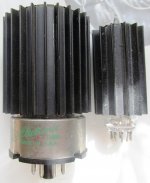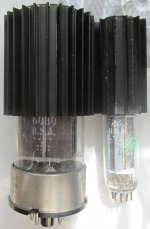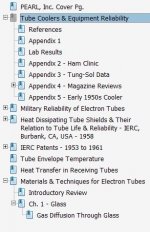I´m rather surprised at the idea that it has caught on commercially, as decades ago I tried a heatsink on a straight NOS EL34 and after a long run the glass cracked hence end of tube. I put it down to expansion differences with unequal thermal coolspot contact, so after that I dropped the idea. A quiet fan running at 1/4 speed under the chassis does equally well.
Sure they loose heat by radiation but boron glass does not let IR through, so glass heats up and thus removes the heat.plates actually live inside a Thermos flask
I am not sure if I am right but glass emits both ways (in and out) and cooling it should reduce the plate's temperature.
It seems in tubes with exposed anode issue is more or less solved as for the rest force air cooling is usually advised.
I hope nobody dares for oil bath ;-)
No figuring needed. Aside from the possible evolution of gas from an overheated anode, cooling the soft glass almost always used in receiving tubes is and always has been the important part. Here is a 198 page collection of information assembled through the last 30 years that puts to rest all the speculation seen in this thread. https://www.pearl-hifi.com/03_Prod_Serv/Coolers/PEARL_Tube_Coolers.pdf See the attachment included here and at least skim everything past "IERC Patents - 1953 to 1961" , pages 91 thru 200.You confirmed by experiment that tube heatsinks are a poor idea (to say it mildly).
Again: best a heatsink can do is to (hopefully) cool the glass envelope, plates actually live inside a Thermos flask, go figure.
Exposed anode tubes were developed around the end of WWII and have been in use ever since. In the mid-90s I had Svetlana, St. Pete, Ru make a few changes to a 300W metal/ceramic triode series pass device that allowed me to then fit a much larger, solid copper heatsink and cool the part with a quiet, low velocity air stream. The data sheet I wrote is seen here: https://www.pearl-hifi.com/06_Lit_Archive/07_Misc_Downloads/RB300_3CX_Data_Sheet.pdf .
Unfortunately, both the USSR and Svetlana Electron Devices , Huntsville crashed and burned about that that time, taking my project with them.
As most are by now aware, Ru tubes are for the foreseeable future a thing of the past. My solution is to move to low power (150 to 300W) metal/ceramic parts that have been around since the mid-50s. This link will get you 344 pages of GE metal/ceramic tubes information https://www.pearl-hifi.com/06_Lit_A...amics/GE_Ceramic_Tube_Reference_Data_1965.pdf whilst this one will pull down 134 pages of data on the 4X150/250A https://www.pearl-hifi.com/06_Lit_Archive/08_Tube_Data/Metal_Ceramics/4X150A_Consolidated_Data.pdf
Conventional tetrodes suffer from secondary emission issues when the anode voltage approaches that of the screen, see the 'kinks' in the anode characteristics in the 4X150/250A parts. Run as tetrodes, this limits the available anode swing when run at anode voltages <1KV. Run as tetrodes over 1KV one faces all the problems seen in pentode and beam tetrode receiving tube amps, i.e. the sharp cutoff in class AB operation when entering the Class B mode and the "notch distortion" caused by the parasitic capacitance resonating with the half-primary to half-primary leakage inductance in the output transformer.
There is a solution for that which for the time being will remain in my "Secret Sauce Dep't" while I bring into being in a newer version of the power amp seen here https://www.pearl-hifi.com/03_Prod_Serv/SC_180/SC_180.html All that lovely chassis work will go unbuilt and new metalwork built using the heatsink assembly seen in the RB300-3CX data sheet is designed and built.
======================
Below is a relevant snip from "The Audio Voice" seen here https://myemail.constantcontact.com...ubes-.html?soid=1104292817535&aid=BGbFhMSL-Hw
Meeting Supply for Vacuum Tubes - Time to Save Those Tubes?
Supply chain issues are a familiar problem for product-oriented and manufacturing businesses and the last two years have shown how extensive the consequences of any disruptions can be. For most consumers, the semiconductor shortage was the most visible sign of the market interdependency problems, where natural disasters in one country can cause ripple effects all over the world. The effects of the global pandemic have thrown a powerful combination of multiple, consecutive disruptions that are causing long-lasting shortages in the most unsuspected places.
Over the last two years, the audio industry has felt the direct effects of those disruptions in the supply chain across all its market and product segments. While "chip shortages" have been extensively debated in mainstream media, a much less visible shortage of apparently non-critical electronic components is actually causing wider-reaching problems for all manufacturers who have been unable to meet demands, some even forced to stop production completely while implementing product redesigns to offset those challenges. And after two years, audio manufacturers - as in many other industries - have transitioned from just-in-time and build-to-order strategies, to design for availability.
More recently, the cumulative effects of lockdowns and geopolitical tensions have caused even more strain over the supply of raw materials, directly reflected in escalating costs for aluminum, neodymium, and even more common materials such as steel and nickel. Adding the escalating transportation costs and shipping delays generates a perfect storm that is causing a complete rethink of non-essential product production. And I would like to highlight how manufacturing and logistical challenges are causing despair among many startups and entrepreneurs dreaming about new product categories and brand strategies - including the thousands of innovative crowdfunding campaigns in the electronics space that have suddenly become not viable and impossible to execute.
The global supply chain was already feeling all the severe effects of two years of pandemic, when the invasion of Ukraine and the resulting sanctions imposed on Russia further impacted the supply of raw materials, and many important parts and components. It's a known fact that both Ukraine and Russia are important suppliers of raw materials, particularly steel and aluminum, but also many critical parts and components for the electronic industry. But the scale of the impact on vacuum tube production seems to be much larger than we could imagine.
The invasion of Ukraine and the resulting sanctions imposed on Russia are obviously having a significant impact on the global supply of tubes, but the scale of that impact seems to be much larger than we could imagine.
As AudioXpress is getting ready to send its traditional Glass Audio May 2022 "tube issue" to the printer, most of the traditional amplifier tube suppliers have gone silent. The current situation is obviously having a significant impact on the global supply of tubes - of all the product categories that are so dear to the audio industry.
This week, while we were already in contact with some of those suppliers trying to assess the scale of the problems, companies started to make their positions more clear. Many of the European and US-based suppliers and distributors of tubes have stopped taking further orders, and some websites were temporarily suspended. AudioXpress received an update from Tube Amp Doctor Musikhandels GmbH, an established supplier of amplifier tubes, which has been around since 1993, always with products designed in Germany but outsourcing its manufacturing from China.
"Without a doubt, the current situation on the tube market can be classified as dramatic,” they state. As Tube Amp Doctor explains, for years, manufacturing for the most common tube types, such as 12AX7, ECC83, EL84, EL34, and 6L6GC has been dependent on only three manufacturers. Following the closing of the Shuguang Electron Tube Factory operation in August 2019, the largest manufacturer of tubes in China, which has not reopened during (and probably because of) the pandemic, Tube Amp Doctor says that it is now working with a small manufacturer in China since 2020, but that facility is only producing the larger volumes types, while gradually introducing the production of further models.
============
In light of the immediately foregoing it's perhaps worthwhile to consider ways and means of preserving the remaining service life in one's existing tubes.
Attachments
Last edited:
I have made some tests (rather radical) with heatsinking, and it does provide improvements: not exceptional, but not negligible either:
https://www.diyaudio.com/community/...rging-a-e-pcl82-amplifier.351667/post-6134055
https://www.diyaudio.com/community/...rging-a-e-pcl82-amplifier.351667/post-6134055
It was classic to run the 19W metal 6L6 in a can of oil to get huge power for short periods in ham radio.I hope nobody dares for oil bath ;-)
Elvee - thanks for linking to that 'totally conductive' cooling exploration with the PCL82 - I had missed seeing that.
In Oz, the equivalent 6BM8/ECL82 was widely used during the 1960's for TV and audio, and there is a huge supply of used examples. From a recent batch of 83 'pulled' valves I tested each one and ended up with 17 matched pairs (for PP amps), and an additional 34 ok pentodes (the triode grid was leaky) - so 68 were ok for SE amps. Certainly one option is to use just the pentode portion of the 6BM8 if it is still ok (ie. even with a leaky triode input grid), so having a simple method to modify a noval power pentode with nominal 7W anode dissipation limit to one which can cope with significantly more anode dissipation is enticing. Given their ubiquity here, there would be no incentive to make the 'heatsink' removeable.
For a simplified example of a 460degC anode and 160degC inner glass (eg. simply neglecting radiation through glass and making everything an average), then if the inner glass temp were lowered to 60degC (by modified cooling of the glass via outer conduction) the anode temp would lower by about 15degC based on the (T^4 - T^4) relationship. In the context of reducing the hottest portion of the anode structure by circa 15C from say 460C to 445C, then that may better indicate the increased anode dissipation headroom available to bring the anode back to 460degC.
One advantage of operating with a lowered inner glass temperature is that it is one contributor to outgassing, and hence service life, although it may be worthwhile avoiding covering the glass where getter has been deposited as that may noticeably modify the getter operation.
In Oz, the equivalent 6BM8/ECL82 was widely used during the 1960's for TV and audio, and there is a huge supply of used examples. From a recent batch of 83 'pulled' valves I tested each one and ended up with 17 matched pairs (for PP amps), and an additional 34 ok pentodes (the triode grid was leaky) - so 68 were ok for SE amps. Certainly one option is to use just the pentode portion of the 6BM8 if it is still ok (ie. even with a leaky triode input grid), so having a simple method to modify a noval power pentode with nominal 7W anode dissipation limit to one which can cope with significantly more anode dissipation is enticing. Given their ubiquity here, there would be no incentive to make the 'heatsink' removeable.
For a simplified example of a 460degC anode and 160degC inner glass (eg. simply neglecting radiation through glass and making everything an average), then if the inner glass temp were lowered to 60degC (by modified cooling of the glass via outer conduction) the anode temp would lower by about 15degC based on the (T^4 - T^4) relationship. In the context of reducing the hottest portion of the anode structure by circa 15C from say 460C to 445C, then that may better indicate the increased anode dissipation headroom available to bring the anode back to 460degC.
One advantage of operating with a lowered inner glass temperature is that it is one contributor to outgassing, and hence service life, although it may be worthwhile avoiding covering the glass where getter has been deposited as that may noticeably modify the getter operation.
I'd expect any mechanical dampening applied to a tube's glass envelope to lessen microphonic output, both from a stiffening of the vibration path internal to the tube, and from the added weight that can enhance suppression of external vibration coupling through to the tube itself. I found that with EF86 as input stage in a combo amp. However, having a clamp on heatsink that is itself mounted to an amp chassis may negate any vibration suppression from the valve being isolated from the amp through compliance in the tube socket.I would think such a mechanical link could effect microphony of sensitive preamp tubes?
Jim
This is the link for Pearl coolers that works:
https://www.pearl-hifi.com/03_Prod_Serv/Coolers/Coolers.html
https://www.pearl-hifi.com/03_Prod_Serv/Coolers/Coolers.html
- Home
- Amplifiers
- Tubes / Valves
- Heatsinks for tubes?


